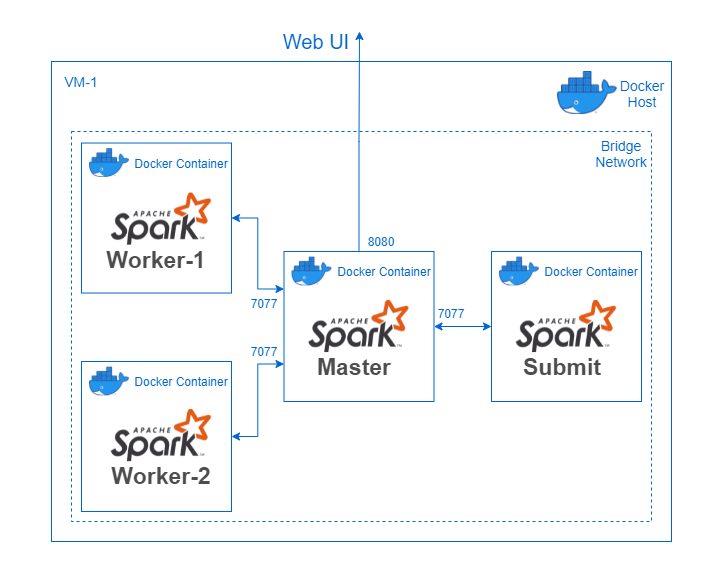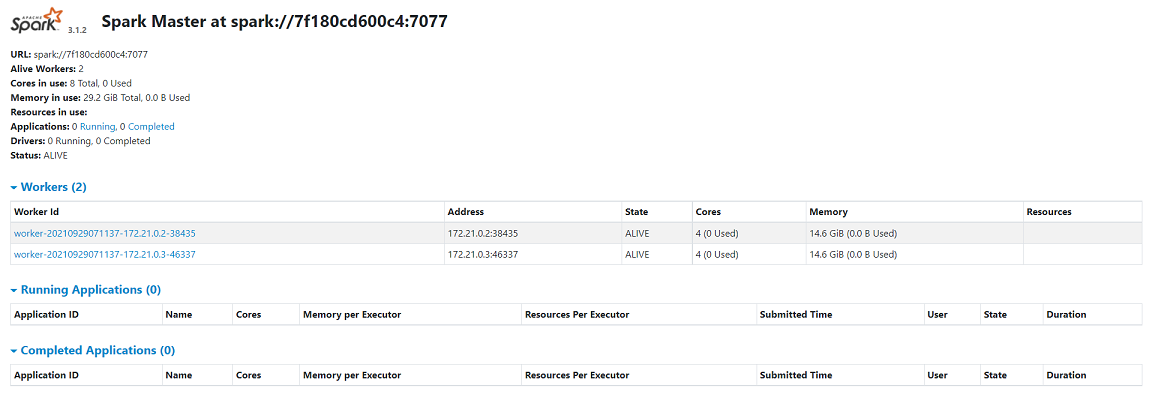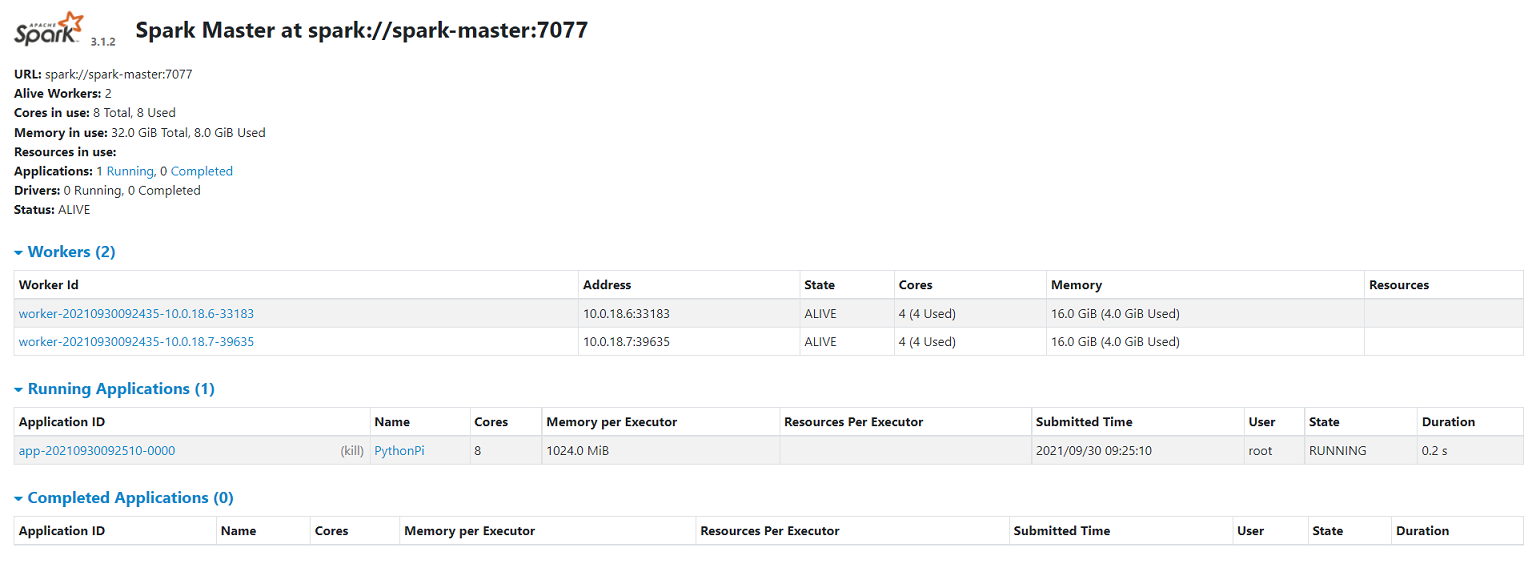Containerized Spark deployment using Docker.
This repository refers to containerized Spark as Spocker.
Kubernetes should be preferred as the orchestrator for prodcution systems over Docker-Swarm.
Deploy containerized Spark (Standalone) inside a single machine (host) using Docker.
- Docker - on (all) Linux Machine(s)
Install docker from here if required.
To deploy and run Spark (Standalone) inside a single machine(host), run the following commands. This runs the spark-master, and spark-worker containers on the same machine/docker-host.
- Clone this repo.
- Execute the docker compose file.
- Submit a spark-job to the Spark cluster.
git clone https://github.com/elaaf/spocker.gitcd spockerdocker-compose -f spark/single-host-docker-compose/docker-compose.yml upThis will pull the latest images for spark-master and spark-worker.
A docker bridge network named spark-net will be created and joined by the containers.
Three containers will be started on the host-machine:
- 1 x Spark-Master: WebUI @ Your-Machine-IP:8080
- 2 x Spark-Worker WEBUI @ Your-Machine-IP:8081 and Your-Machine-IP:8082
If the deployement was successful, the Spark WebUI should be accessible @ YOUR-IP:8080 and should look something like this:
Start the spark-submit container, providing the SPARK_MASTER_URL (optional for single-host: defaults to spark://spark-master:7077) and JOB_PATH.
The contianer will run till the submitted spark-job's life, hosting the spark-driver inside it.
docker run -it \
--network spark-net \
--mount type=bind,src=$(pwd),dst=/spocker/ \
-e JOB_PATH=/spocker/spark/spark-test-job/spark_submit_test_pi.py \
elaaf/spark-submitThe --mount command will mount (bind-type) the current directory at the path /spocker/ inside the spark-submit docker container.
This allows the container to access the code/py-files inside the mounted directory.
The Spark WebUI will show a running application and will move it to completed on completion.
Deploy containerized Spark (Standalone) up-and-running on a cluster using Docker Swarm which is a multi-host container orchestartion tool.
- Multiple nodes/VMs (atleast 2) on the same network, with internet access on atleast one VM.
- Docker installed on each node/VM.
- Clone this repository
- Setup a Docker swarm on the connected VMs.
- Deploy the dockerized Spark
stackfrom the Docker Swarm Manager/Leader. - Submit a spark-job to the Spark cluster.
Designate one of the node/VM as Swarm Manager/Leader.
Be mindful that most commands will be executed ONLY on the Swarm Manager/Lead node/VM.
Docker will automatically propogate the required data to the Swarm Workers Nodes.
Clone this repository:
git clone https://github.com/elaaf/spocker.gitcd spockerFrom the node/VM designated as swarm Manager/Leader, initialize docker swarm:
docker swarm init
This will initialize the node/vm as the Swarm Leader, along with an join-token to join the swarm:
- On all the other nodes/VMs run the following command to join the Docker swarm:
# Run on all other nodes/VMs except, Swarm Leader
docker swarm join --token <swarm-join-token> <swarm-leader-ip>:<port>
- Verify that all nodes/VMs have joined the Swarm, run:
docker node ls
You should get an output similar to below, listing all the nodes in the Swarm and indicating the Swarm Leader:
Spark can be deployed across all nodes/VMs inside the Docker Swarm by executing the compose file with the following command: NOTE: Execute the command ONLY on the Swarm Leader/Manager
# Run this ONLY on the Swarm Leader
docker stack deploy spocker --compose-file spark/docker-compose.yml
This will start the following containers :
- 1 X Spark-Master: WebUI @ :8080
- 1 X Spark-Worker on each Swarm Worker Node: WEBUI @ :8080
NOTE: This docker stack deployment configuration connects the containers to a new swarm-scope overlay network called spark-net.
More details about Docker Overlay Networks here.
Start the spark-submit container, providing the SPARK_MASTER_URL and JOB_PATH.
The contianer will run till the submitted spark-job's life, hosting the spark-driver inside it.
Run the following command on the Swarm Leader:
docker run -it \
--network spark-net \
--mount type=bind,src=$(pwd),dst=/spocker/ \
-e JOB_PATH=/spocker/spark/spark-test-job/spark_submit_test_pi.py \
-e SPARK_MASTER_URL=spark://spark-master:7077 \
-e DRIVER_CORES=1 \
-e DRIVER_MEMORY=4g \
-e NUM_EXECUTORS=1 \
-e EXECUTOR_CORES=1 \
-e EXECUTOR_MEMORY=1g \
elaaf/spark-submitThe --mount command will mount (bind-type) the current directory at the path /spocker/ inside the spark-submit docker container.
This allows the container to access the code/py-files inside the mounted directory.
The Spark WebUI will show a running application (similar to the above image) and will move it to completed on completion.
- Implement Containerized Hadoop (HDFS, YARN)
- Integrate Containerized Spark (YARN) and Hadoop (HDFS)






